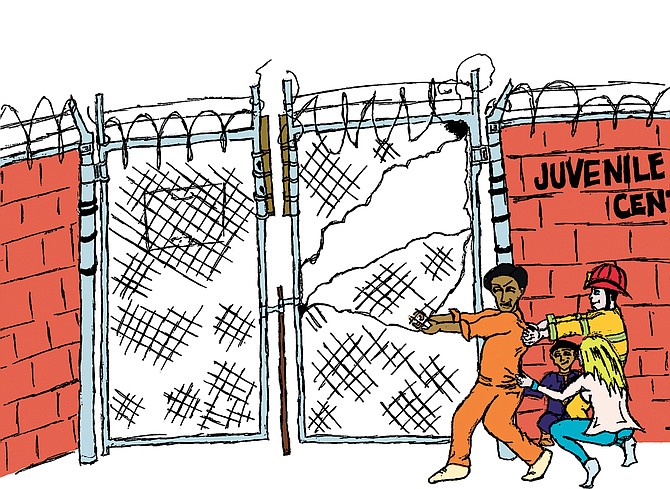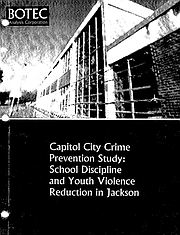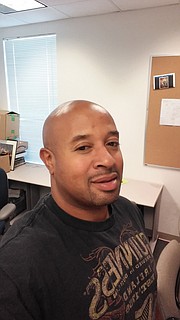"He's out on the street. He comes home sometimes. He has that little anklet, he doesn't care. It makes no difference to him. He's afraid of nothing." The mother of a Jackson teenage boy told her story to BOTEC Analysis researchers in 2015 as part of a state-funded study on Jackson crime. The "anklet" is an electronic homing device placed on the teen so he wouldn't have to go into the criminal-justice system.
"The judge told him he can go home, be on house arrest, or he'll be picked up. But first (the judge) told him, you need to charge this thing (the ankle bracelet) up. You're not charging it. You know what my son's response was? He went off on that (expletive) judge. He doesn't care. He cares about nothing," his mother continued.
Another Jackson mother expressed frustration at her son's experiences with Jackson's juvenile-justice system after he hit his teacher after she shoved him.
"And so they took him and brought him to the jail and put a simple assault charge on. They gave him probation time. And he supposed to be in a program that supposed to come and pick him up every day," she said. "I haven't seen them, yet ...."
Her son was supposed to be in an adolescent opportunity program, historically Mississippi's most successful alternative to juvenile detention in the state. AOPs lost funding this summer, however, because the state's programs were mainly using TANF (Temporary Assistance for Needy Families) funds that the federal government says cannot go to "juvenile justice" costs any longer.
Document
Capitol City Crime Prevention Study: School Discipline and Youth Violence Reduction in Jackson
BOTEC researchers interviewed Jackson youth in the juvenile-justice system in 2014 and 2015, asking them about their experiences with AOPs or ankle bracelets. Most youth reported "generally negative" sentiments.
"'I'm here because I have to be, and because I don't want to have to go be locked up for a longer time,' was a typical answer to the question: 'Do you think that AOP has been helpful to you, kept you out of trouble?'" the BOTEC report on youth says.
The report, released in January 2016, recommends alternative programming that involve "restorative justice" models, which BOTEC says uses a communication-based approach to identify the root causes of misbehavior or Positive Behavioral Intervention and Supports, or PBIS. Both strategies are much more effective at preventing antisocial and criminal behavior in youth than involvement in the juvenile-justice system as it currently exists in Jackson. Some states used this research quicker than others and began implementing alternative programming in the last five years.
Changes to state laws, appropriate funding in the right places, community input and collaboration have managed to put Washington state—and the Seattle area specifically—on the map for its unique and continuous efforts to look to alternative programs, using juvenile detention only as a last resort. One of those programs started with only art in mind.
Getting Creative
Washington Hall sits just a few blocks away from the King County Juvenile Detention Center. The historic concert hall, built in 1908, has seen the likes of Billie Holiday and Jimi Hendrix perform within its walls.
One night earlier this year, community members, family members and even probation counselors, attorneys and judges walked into the hall and began a role play they likely were not expecting.
A group of teens in the Creative Justice program, mainly youth facing charges in the juvenile-court process or on probation, decided to have a role-play performance to culminate their time in the program. Some of the teens dressed as prison guards and reenacted being processed in the detention center. They snapped attendees' mugshots and made them stand in line. Later, teens poured out stories and truth in the form of poetry and musical performances.
Aaron Counts, one of the program's directors, said it was a powerful evening.
"(With) the in-person experience and show, they (the teens) really got into the idea of playing the guard," he said.
Creative Justice is an art-based alternative to juvenile detention. It is a eight- or 12-week program, where teens involved with the King County juvenile-justice system meet twice or three times a week for a couple hours with their mentor, a local artist who is engaged with the community. The young people create art and discuss issues with the criminal-justice system, share stories, or discuss system change and how that can be reflected in art. The program was originally developed as a response to the disproportionate number of youth of color entering the juvenile-justice system.
"How can we address it (that problem) through arts?" Counts said. "And you know, arts is a great way to get at a lot of those issues but not just in terms of altering the experience for young people, but also, how can we use the arts to sort of nudge the system in a different direction too?"
Counts brings in lead artists, four per year, who mentor participants and address how racism, sexism and economic oppression play out in institutional systems. In that safe environment, young people create art to explore those issues and build their own peer group community with similar experiences.
At the end of the program, the group produces a culminating project, and depending on what type of artist the mentor is—from a musician to a poet to a visual artist— and what the teens want to do, the final project could be anything from a mixtape to an interactive theater production to a book of poetry written entirely by the participants.
The program is not technically court-sanctioned, so probation officers or defense attorneys refer young participants, Counts said. He and his artists do a lot of outreach and recruiting. It is important that youth cannot be penalized for choosing not to participate or dropping out, Counts says, because they didn't want to become another tool used to detain or punish youth in the community.
Creative Justice is funded through the public arts department of King County's arts and cultural services wing, called 4Culture, and through National Endowment for the Arts grants but not through the juvenile court's funding for alternative programs. Counts said they've been careful about taking money from the court on purpose.
"It becomes a different relationship when someone is telling you (that you) have to be somewhere, right?" he said. "So you're not going to get your best creative work, you're not going to be as open to a bigger discussion. Your attendance might be better, but apart from that, we really believe that the community has the best ideas about addressing its needs, and if we are just another branch of the same system, how can we be different?"
In its first year, 48 young people participated in the program, and as a result of participation, 33 charges were dropped for some of the youth.
More Than Fresh Paint
Pam Jones, the director of the county's juvenile-detention division, runs the detention facility in King County, Wash. The facility has converted an entire living unit of the detention center into a short-term housing facility and center for young people brought to the justice center due to complaints or charges relating to domestic family violence. In July, Jones walks down a few flights of steps to the underbelly of the detention center.
"We had to take a wall down," Jones says walking into the new space, in order to put in a door. The walls of the new Family Intervention Restorative Services, which is called FIRS for short, are brightly painted inside and the mood is more cheery than throughout the rest of the center.
King County is the largest county in Washington state, with a racial makeup closer to Rankin County here but with a population of over 2 million people.
As the state's largest county, the juvenile-detention division naturally gets a lot of action and attention. The county can afford several alternatives to detention, diverting kids away from the building on Alder Street.
While some alternatives would be challenging for counties in other states to replicate, others don't even require building anything new. Coordination among several city agencies and departments as well as the willingness to convert an unnecessary wing of the detention center into a respite center for youth facing familial domestic violence charges is something that could be replicated elsewhere, Jones said. FIRS works due to the willingness of the prosecutor's office to not charge the youth for assault as long as they sign a safety plan and contract instead.
Paul Daniels, a juvenile-court services manager in King County, says the goal is always to reunite the family in a safe way, and as long as the youth agrees to participate in FIRS, the youth's charges go away.
The entrance to the FIRS wing of the detention center looks like a simple waiting room with two chairs, but once inside, you can tell they've worked hard, aesthetically at least, to ensure youth who enter this wing know they aren't being locked up. Outside this wing, a metal detector is a little farther up the hallway providing a security checkpoint into other parts of the detention center.
Inside the FIRS wing bricks and doors are covered in a brightly painted landscape: trees, rivers and a brilliant sunset. The old cell doors are barely noticeable behind fresh paint.
FIRS is for youth who commit misdemeanors or even some felony assaults that are related to familial domestic violence, targeting what King County found recently as the most commonly reported new offense youth commit, Daniels said.
The program uses social workers from the county's Step-Up staff, a national family-violence intervention program and initiative, as well as juvenile-probation counselors and staff from their nonprofit partner, Pioneer Human Services, which provides the staff inside the FIRS wing. Jones said, ideally, FIRS wouldn't have to be in the detention center, but she said it is also easier for law enforcement who are already used to bringing youth to this building in the first place. Daniels agreed, saying that with logistics and the tight budget that the program operates on, having it reside in the detention center for now helps save money.
The main space looks like a living room, with rugs and lounge chairs. The back hallway has more rooms that haven't been painted yet. The rooms still look like jail cells with metal latrines and bunk beds, but with bright bedspreads and pillows on the bunks—a sign the space is not supposed to feel like kid jail.
A young man sits in the middle of the room at a round table with a counselor who is wearing what looks like a white lab coat. They speak in low tones, and two young workers, from the nonprofit, in matching t-shirt uniforms, lead a short tour.
The counselor has finished speaking and leaves, and the boy doesn't look around before heading to the room he has chosen as his own. He just turns on his heel, his socks sliding across the floor, and seems to dive headfirst into his room. The door bounces to a close behind him, like the glass doors that protect pizzas and breakfast sandwiches in the frozen-food aisle, and then it's silent.
Beyond 'Catch and Release'
Jackson lacks the programming options that King County offers, and one could argue that it is largely a funding problem. Beyond sitting in Henley-Young, young people in the juvenile-justice system in Jackson only have, or more accurately had, the option of AOPs. However, as Jones and other King County staff found, it is possible to use existing spaces—and staff—to keep kids out of cells and help them receive the care, and counseling they need.
King County is a Juvenile Detention Alternatives Initiative, like five counties in Mississippi, which means they follow a specific philosophy and protocol to ensure that youth are adjudicated fairly even from the point of intake. As of 2012, King County had reduced their average daily population of detained youth by 63 percent, the 2014 JDAI annual report shows. Before using JDAI strategies, the county's ADP was 188 kids, and by 2012, it was 70. One JDAI alternative strategy, replicated by several detention centers not just in Washington state but around the country, is electronic home monitoring: an ankle bracelet that tracks a youth's location.
Jones said offering an ankle bracelet as the only option is not enough and that alternative programming, and even programming for youth who have to be in the detention center longer term, needs to add value to the kids' lives or else they will feel disconnected.
"Don't let alternatives just be ankle bracelets," she said in July.
Daniels and Ryan Pinto, who is also a juvenile-court services manager in King County, both agree that money and staffing aren't enough to sustain alternatives, however. It takes more effort to keep programs evolving and to maintain the changed norms that alternative programs create.
"JDAI is great, but it's important to build the infrastructure behind them," Pinto said in July. "For example, if Pam left, where would they be?"
King County's menu of detention alternatives has helped keep the number of juveniles in long-term detention fairly low.
"No system can rely on the existence of one person," Daniels said. "It's about changing the management and getting people to buy into those philosophies."
This year, King County's detention facility's average daily population has been around 50 kids so far. On Aug. 15, there were 53 kids in secure detention, with 23 kids in alternatives. These numbers do not include the thousands of youth served by the county's diversion programs and other alternatives. Around 600 kids are on probation in the county.
For perspective, in 2011, before Henley-Young was under a consent decree to dramatically change practices at the facility, there were 37 kids held at Henley-Young when the Southern Poverty Law Center and Disability Rights Mississippi filed their lawsuit. Hinds, however, only has a population of 245,000 compared to King County's over 2 million.
All the King County administrators admit that there is still work to be done and freely admit that kids still sit too long. Outside Daniels' and Pintos' office, a sign reads, "Every kid is one caring adult away from being a success story."
Jackson youth and parents involved with the juvenile-justice system describe their kids' first and second offenses as "catch and release." When juveniles are brought to Henley-Young, for instance, it's a familiar experience for lots of youth.
"I see my friends in there, you know, my cousins, whatever," a young man told BOTEC researchers in 2014. "I go in for three days, a weekend, my first couple times ... it was straight (fine)."
Youth here often sit in detention even after committing minor offenses because there are few other options—beyond ankle bracelets—for the youth court to choose.
From a policy perspective, Washington state is a few steps ahead of Mississippi. Since that state adopted the Juvenile Justice Act of 1977, it has implemented and adopted "diversion"—a program that allows the juvenile court to divert youth offending for the first or second time to meet with a board of community members, pay a fine, participate in counseling and perform community service to keep their records clean. The law there forced counties to start looking at alternatives to detention several decades ago, but the option to participate in diversion still lies with the prosecuting attorney's office.
The diversion program isn't perfect, but Jimmy Hung, the deputy prosecuting attorney in the King County prosecuting attorney's office said the idea behind the program is acknowledging that while most kids growing up will likely do something that could be charged as a crime, only some will get caught. Diversion is a way to hold kids that do get caught for crimes accountable without them incurring a criminal history for their futures. Hung said his office looks at several diversion options for a youth before ever filing charges.
One of the downsides to diversion is that it costs money. Youth used to have to pay $263 to participate in the diversion program, but recently, that cost has been dropped to around $100, Hung said. Washington state's youth-court proceedings are much more advanced due to the 1977 legislation as well. Youth court in Seattle is open to the public and convictions are public record. Diversion meetings, however, are confidential the King County website states, so that a young person can truly have no conviction or criminal record once he or she completes the program. The cost of diversion can be difficult for families, Hung said, and other programs, like the 180 Program, can help combat the price-tag hurdle.
Not 'Scared Straight'
It all started at a high school football game when King County's head prosecuting attorney in juvenile court, Dan Satterberg, met Doug Wheeler and had an informal conversation about how to keep youth of color out of the juvenile-justice system, especially when they were entering with low level misdemeanors.
Wheeler sat down with community leaders, including the current program director Dominique Davis, and came up with the 180 Program, which now helps diverts hundreds of youth from the system each year. The program started in 2011 as a partnership between the King County prosecuting attorney's office and Rainier Valley 98118 Leaders Roundtable.
Davis, a local middle-school track coach and trainer, who goes by Coach Dom, leads the program today. He grew up on the streets of Seattle, leaving home at age 13. He grew up fast and skeptical of the criminal-justice system. "I was out here hustling, so I had no trust for the police, no trust for prosecutors or any judges—I hated those people," he said.
So when Satterberg approached Wheeler, Davis and other community leaders about starting the program that would not only divert youth from the detention center and the formal diversion program but also be free and wipe their charges clean, Davis says he was "flabbergasted."
Five years later, the 180 Program is still going strong. It's a four-hour, seminar-style course, held on Saturdays once a month at the Seattle University Law School, which allows the program to meet there for free. Youth referred from the prosecutor's office only have to attend once to get charges—usually misdemeanors or low-level offenses—wiped clean.
Both Hung and Davis insist that it is not a "scared straight"-style program; researchers say that threatening young people into avoiding crime is seldom effective.
Speakers include people from the community, many of whom have experienced the criminal justice system: some who have been in jail or prison, some addicts who got clean and other community stakeholders. They give 10-minute testimonials as a part of the seminar, followed by breakout groups and small group sessions.
What sets the program apart is two-fold: parents can come with their kids; and all of Davis' staff are trained in restorative justice, trauma-based care and motivational interviewing in order to lead the discussions. Those mentors are called community ambassadors.
Davis says the real work starts after the four-hour seminar, in what he calls Beyond 180, when community ambassadors follow up with youth, making sure they get the services they need, and in most cases, help them get back in school. Youth who went through the program recidivated at a statistically lower rate than a comparison group used in King County's budget office's study of the program. Davis attributes this success to the heavy community involvement in the program.
Pierce County, next door to King County, with similar demographics and a population of 843,000, has worked hard over the past few years to bring down its detention rates. The site uses the Annie E. Casey Foundation's JDAI model, too, and saw their ADP drop by 77 percent after they implemented JDAI alternatives to detention. The county has also found that much like King County, while they were able to lower detention rates rapidly, youth of color were still grossly overrepresented in their justice systems.
Pierce County is a 75-percent "white alone" county, census data show, with about 7 percent African American representation. In 2015, however, 80 percent of the youth re-committed to the county's juvenile-justice system were African American. King County has a similar problem. All good research shows that juvenile arrest and incarceration disproportionately affects black youth.
In Jackson, young people who have been through the juvenile-justice system as well as those who work within the system all seemed to agree on one thing in 2014—the juvenile-justice system as a whole isn't working. That is especially true for its inability "to rehabilitate those young people who were arrested, adjudicated, incarcerated and reintroduced to school and community," the BOTEC study says.
BOTEC warned that one of two primary indicators of a young person turning to violent crime is previous contact with police and the criminal-justice system; the other was dropping out or missing too much of school.
"Well, if you assume the whole point of the police, the youth court, and Henley-Young is to 'graduate' youth to the 'college' of adult prison ... you know, it's working perfectly," one Jacksonian told BOTEC researchers in 2015.
Eliminating Racial Bias
Kevin Williams, who has been in Pierce County juvenile-court work for well over 10 years and is the probation manager there, saw his county transition from using punitive measures in juvenile justice—which meant a dorm-style jail used to house kids mainly with probation violations in the early 2000s that the county decided to close.
"In 2004, I remember it clearly because I was a juvenile probation counselor at the time," Williams said. "We showed up to work on Monday, and the building was closed."
Pierce County now is working to continue to reduce the number of commitments of youth to its detention center, as well as lowering the racial disparities that continue. Williams said he and his team are working to increase the participation of African American youth in the county's various alternative programs, like the evening reporting center.
"It's an issue we're consistently wrestling with," Williams said in July.
"If you look at any data in the system on the offender side or the civil stuff, African American kids are way more likely to be a part of our system and go deeper into it compared to their counterparts."
King County admits to similar racial bias in its system as well, and court administrators and attorneys said it is an issue they are constantly talking about and working on. Beyond equity issues, alternative programming across the board is much cheaper than detention, and that is a fact all stakeholders can agree on without dispute.
When asked if alternatives in Pierce County, including the evening reporting center which is a partnership with the local YMCA (similar to the AOP program in Mississippi) are cheaper than holding kids in detention, Williams didn't hesitate. "No doubt, no doubt," he said confidently.
In King County, the 180 Program gets its operational funding from the King County prosecutor's office (while the community leaders' roundtable applies for additional grant funds for work done after the seminar).
The program costs $150,000 per year, which might seem like a lot but is pocket change compared to the costs of kids being detained in the facility on Alder Street. Hung said the cost of housing one kid in secure detention for a year in Washington is around $100,000. So for the cost of housing eight kids in detention for one year, the 180 Program has diverted almost 3,000 kids away from the juvenile-justice system entirely.
Hung says the prosecuting attorney's willingness to participate in the program is crucial and key for similar programs to work in other counties or start at all. Two studies of the 180 Program have shown that it is more effective for youth of color, namely black youth. While cooperation from administrators, judges and prosecuting attorneys is crucial, Davis and Counts both agree that community is at the heart of reducing juvenile incarceration.
"Community has to heal community—not no government entity, not no guy, with a PhD or some kind of degree ... not no outside organization that somebody contracts and brings into the 'hood to come in and deal with our kids," Davis said. "It has to be people from the community that look like the people in the community, that live around the people in the community, that work around them and go to church around them and know that community and have experienced some of the same things that they're experiencing."
For more stories about juvenile justice in Mississippi, visit jfp.ms/preventingviolence. This ongoing project is supported by a grant from the Solutions Journalism Network.







